At least six months ago, we reserved much sought after tickets to tour Salvador Dali's home he shared with his wife, Gala, in tiny Port Ligat, about an hour's drive away on the other side of a mountain from where we were staying in the Costa Brava region of Spain. It had stormed all night long and was still pretty miserable so we had a cloudy view as we looked back to Roses, our 'home away from home' in Costa Brava.
Just in case the bad weather and the windy road wasn't bad enough, there were a slew of Catalunya independence signs along the barriers to take your mind off driving!
The guide told our small group the initial room in the house was called Hall of the Bear! The Canadian polar bear was placed in the entrance way to welcome people. I wonder if that was Dali's only connection with Canada!
The most important room in the house was his Studio which had a mechanical easel system with pulleys and a motor because he painted sitting in this chair and never had to move. The easel went down into the ground and could be moved up and down.
Dali painted eight hours a day, seven days a week each spring and summer when he had the best light in Port Ligat. The rest of the year he traveled to Paris and New York to arrange shows but he found his inspiration in tiny Port Ligat. It gave me chills to be in the same room where such a legendary painter spent so much of his time and created such masterpieces.
I loved how Michelangelo’s David sported a fencing mask!
The master bedroom was the only bedroom in the home.
In the Dressing Room, Gala had a collage of photos she'd amassed of her and Dali with various famous people.
The phallic-shaped swimming pool was the site of orgiastic parties apparently.
I wondered if those may have been sculptures of Salvador and Gala overseeing all the shenanigans at the pool!
The Iglesia de Santa Maria was built in the 16th century.
What a lovely view into town from the church courtyard. The smell of the sea was very strong even though we were a long way up.
It was a tough slog walking up to the lighthouse and restaurant for some better views as the winds were so strong.
Next post: Through the Spanish and French Pyrenees to the principality of Andorra.
Posted on December 9th, 2018, from Lisbon, Portugal.
The clouds parted enough so we could see the observatory atop the mountain in the distance.
Dali's home was close to the town of Cadaques which had been a haven for intellectuals and artists alike since the late 1800s. The fishing village's rocky coastline and summertime sun-drenched colors had inspired Matisse, Magritte and Duchamp. Even Picasso, drawn to the charming coastal haunt, painted some of his Cubist works there.
I was sure glad Steven was driving as it was one of the windiest roads with very quick switchbacks we'd ever been on. It would be glorious in the sun but more of an adventure that morning!
Just in case the bad weather and the windy road wasn't bad enough, there were a slew of Catalunya independence signs along the barriers to take your mind off driving!
You can see how many twists and turns the road was to the other side of the mountain!
Even with a nonstop drizzle and the gray skies, Cadaques looked charming with its whitewashed homes and red roofs. We looked forward to walking around the town after our tour of Dali's home.
Dali's home was located in the fishing hamlet of Port Ligat, a short drive from Cadaques. We arrived with enough time to walk the few steps to the rocky shore and see the fishing boats before our timed tour as only 8-10 people were allowed in every 10 minutes and we didn't want to miss our slot.
The bay around Port Ligat was ringed by sleepy islands.
About five minutes after Steven took this photo, the heavens opened and it poured cats and dogs!
Our first sight of Dali's home which overlooked the bay:
Over time, Dali and Gala had bought seven fishermen cottages in Port Ligat to use to expand their original small home and others as guesthouses for their friends. One was since turned into a waiting lounge so guests could watch a video about Dali and see the walls plastered with media coverage about him.
The guide told our small group the initial room in the house was called Hall of the Bear! The Canadian polar bear was placed in the entrance way to welcome people. I wonder if that was Dali's only connection with Canada!
Everything except for the books in the Library was original and was as Dali left it when he moved out shortly after his beloved wife died in 1982. Look at his collection of chairs representing Goldilocks and the Three Bears in the dining room! In the 1930s, the converted entrance room was the entire house; that was why Dali and Gala joined other houses together to make theirs larger.
The Library:
The radiator was from the 1950s but it was covered to camouflage it as Gala didn't like seeing it unadorned! Prior to the 1950s, the home was only heated by fireplaces.
The objects on the stairs were toys Dali had as a child or presents he was given or he bought himself, according to our guide. The home seemed so livable and down to earth. No visitors or guests were allowed in the home - all entertaining was done on the patios or in the pool area as Salvador and Gala were very private.
Dali painted eight hours a day, seven days a week each spring and summer when he had the best light in Port Ligat. The rest of the year he traveled to Paris and New York to arrange shows but he found his inspiration in tiny Port Ligat. It gave me chills to be in the same room where such a legendary painter spent so much of his time and created such masterpieces.
I loved how Michelangelo’s David sported a fencing mask!
This was Dali's view from his study window!
Ivy: I don't know how much of a fan of Dali's art you are, but even if you're not, I would think you would have been amazed at also seeing his studio and his tools and brushes.
Dali painted using microscopes in a dark room.
A painting Dali did of his wife: We'd just seen the original at the Dali Theater-Museum in Figueres the previous morning!
This was their Yellow Room, so called because of the color of the divan and the local wildflowers Gala loved and collected.
Dali designed the olive wood table; the Tiffany lamp on it was purchased in NY.
Dali was always fond of saying he was the first Spaniard to see the sun each morning as Port Ligat was the easternmost spot in Spain and he could see the sunrise reflected from this mirror through the window onto their bed.
The next room was called the Bird Room because of the canary cage that took up so much space in it.
The master bedroom was the only bedroom in the home.
In the Dressing Room, Gala had a collage of photos she'd amassed of her and Dali with various famous people.
With Ingmar Bergman:
With Gregory Peck:
With Ed Sullivan:
With Pablo Picasso:
Next to the Dressing Room was the Oval Room which had special acoustics because of its shape. It was designed for a disco in Acapulco but, when it was found to be too noisy there, Gala had Dali design one just like it as she loved its echo effects so much.
Gala and Salvador were together for 57 years before she passed away even though she was ten years his senior when they met.
After the house tour ended, we were able to wander at leisure through their extensive gardens and patios.
The outside dining room:
In true Dali style, there was an upside down mirror in one of the outside spaces!
Who couldn't smile seeing the mammoth eggs atop the roof?!
The view of Port Ligat from the patio:
It seemed pretty apparent that Dali must have had a 'thing' with eggs. Steven was a real trooper climbing into the egg from the bottom when I asked!
It was fun watching home videos of parties Dali and Gala had at their home.
There were large olive gardens surrounding the home which we were also able to wander through.
There were also nooks and crannies throughout the estate. I spotted this sculpture but don't know who it was of - possibly Gala?
The hot pink lips sofa reminded me of the one we'd seen just yesterday in the Homage to Mae West Room in his museum-theater. I was surprised the pool area was totally open to visitors and not roped off at all. I wonder what the connection was between Dali and tires as they seemed to play a strong role in his art.
Speaking of tires, here was the Michelin tire figure!
There were so many fanciful details in the pool area, it was hard to keep my head from spinning side to side to take them all in!
I wondered if those may have been sculptures of Salvador and Gala overseeing all the shenanigans at the pool!
Having spent a few hours exploring so many incredible facets of Dali's home and party spaces, I could see why the home had been described as one of the best artists' homes in Europe. It was wacky, wild and wonderful and gave us a great insight into the Dali's artistic genius and his profound love for Gala.
We left our car across the small bay in Port Ligat and walked down a stone path over the hill toward Cadaques.
The path dropped us directly on the town's seawall just feet from the stormy waters.
You can see how close we were to the waterfront as we made our way into town. The winds had picked up terribly but it wasn't too cold, thank goodness.
It was hard to know where the sea ended and land began!
On the waterfront in town was a statue of the debonair Dali.
It obviously wasn't a day to sit in a cafe and enjoy watching the world go by so we decided to walk up to the church we'd seen before that was at the top of the town.
The whitewashed buildings looked so charming as did the entire town, even if we weren't seeing Cadaques at its best.
A painting by Dali graced the church.
It was very unusual to put it mildly seeing cushions on the floor in the church. I didn't know whether it was a temporary thing for some event or they were there permanently.
What a lovely view into town from the church courtyard. The smell of the sea was very strong even though we were a long way up.
As you might imagine, there were a lot of stores selling all manner of Dali merchandise.
Maureen: We were sure glad to have our raincoats that I'd purchased with you at Costco when the rain started up again on our walk back along the waterfront. One huge gust of wind resulted in waves soaking our feet when they came ashore and we had no place to escape to as we huddled up against a building.
Steven had wisely worn his rain pants he'd brought for our horse trip way back in Kyrgyzstan and also many times since, so 'only' his shoes and socks got wet.
Seeing the 'birds' on our walk back over the hill to Port Ligat reminded me that Dali had designed a sequence for Spellbound, one of Alfred Hitchcock's films!
As we were so close to Cap de Creus National Park, just 15 miles south of the French border, we decided to head there next. The extraordinarily craggy, wild, promontory took us high up into the clouds on the eastern tip of the Spanish peninsula.
It was hard to tell where clouds began and the sea ended as they all blended together.
We only passed a few other equally crazy people out for a drive in the barren, windswept landscape.
It was a tough slog walking up to the lighthouse and restaurant for some better views as the winds were so strong.
On a warmer and windless day, it would be spectacular to do some serious hiking at Cap de Creus.
Thank God there was a barrier to hold onto at the uppermost point because I have never experienced such fierce winds as I did then. I had never been scared of the wind before.
There was a long trail between Cadaques and the lighthouse which, I'd imagine, could well be one of the most scenic on earth when the winds aren't howling, thereby making it a treacherous hike. In all my posts about our fantastic time in the Costa Brava region of Spain, I neglected to mention that it means the 'wild or craggy coast.' We felt every bit of its wildness that short time we ventured to Cap de Creus National Park!
Next post: Through the Spanish and French Pyrenees to the principality of Andorra.
Posted on December 9th, 2018, from Lisbon, Portugal.







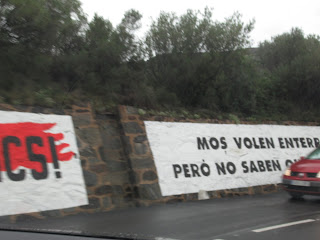

























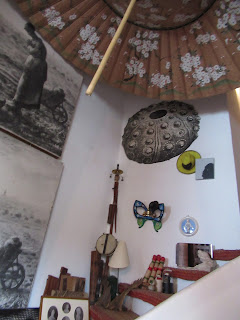




































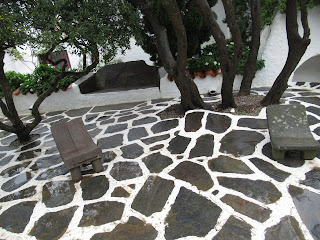





















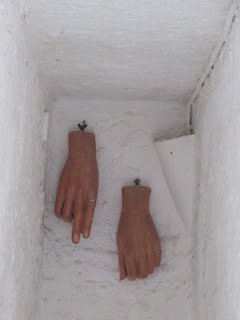
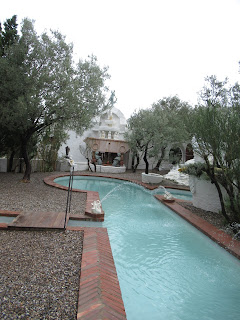
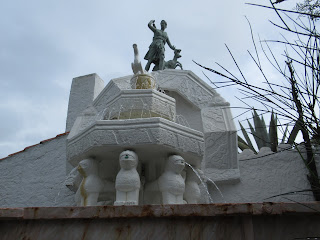




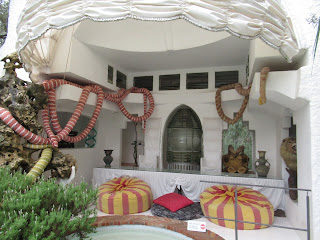































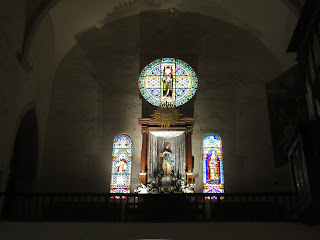



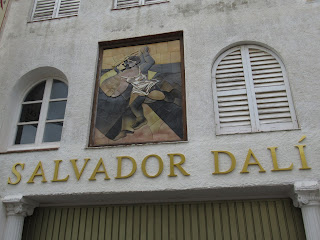





















No comments:
Post a Comment